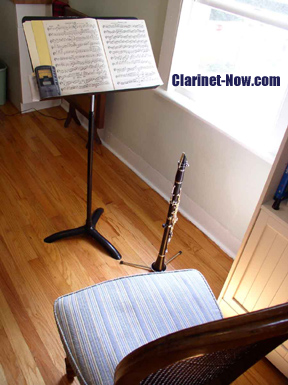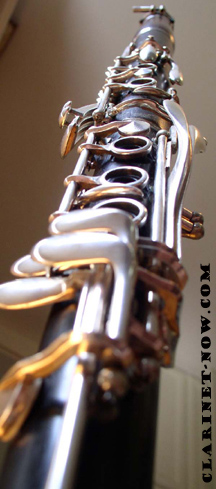Clarinet Sight Reading Lesson
Free Online Clarinet Lesson #6
This Clarinet Sight Reading Lesson spells out ten basic tips to improve your musical literacy.
TEN TIPS
Listen to this Bumblebee
Yep, I played this Flight of the Bumblebee on Clarinet accompanied by a Squeeze Toy Giraffe. If you want to learn how to increase your speeds for any piece, etude or scale, the information is all here on Bumblebee Loops.
By the way, the video is not AI generated.

1. Do it! Improve your musical literacy. Sight-read on your own. If this Clarinet Sight Reading Lesson does not teach you anything else, get your clarinet method books out and start on page one. If the music is too difficult for you, play it slowly enough to play it accurately. Subdivide the rhythms.
Play slowly and accurately. Accurately. ACCURATELY.
That is the key. The more accurately you play it, the better habits you will form in sight-reading. Speed will come, but dare to play SLOWLY at first.
2. Check the time signature. Are you in 4/4, 3/4, 2/4, 6/8, cut-time or several different time-signatures on the same page?
Are you primarily in duple or triple time?
3. Check the key signature – the true secret of knowing keys is to know scales. Learning scales, thirds and arpeggios will give you a massive advantage in deciphering a new piece of music and knowing, feeling and hearing the key signature.
4. Figure out your tempo. Check the musical description on the piece. Learn your common tempo musical terms from Largo – very slow to Presto – very fast. If your tempo description is on the fast side, do not sight-read faster than it takes to succeed.
Clarinet Sight Reading Lesson Golden Nugget - It is better to read accurately on the slow side of the tempo than poorly on the fast side.
5. Look for accidentals (outside the key signature). Are the accidentals a result of harmonic or melodic minor scales? What are those? Learn your harmonic and melodic minor scales and you’ll have another advantage to becoming a better sight-reader.
Watch for accidentals that carry through the bars. Many young sight-readers catch the first marked accidental, but do not carry it through during the measure. This is often very irritating to the judge/music teacher. That’s okay; it’s irritating to me when I let an accidental slip while I’m playing. When you get to the point of hearing your own mistakes, you are well on the way to becoming an accomplished clarinetist.
6. Pick out difficult rhythms and syncopations and figure them out. Count them out in your head and finger through them. Subdivide rhythms in your head before playing them.
One pitfall many young players fall into is not playing simple or long rhythms full value. What do I mean by this? Many players arrive at a whole or half note, play the pitch and then move on regardless of the rhythm. This also happens with whole and half rests.
Young students are often so energetic about playing, or sight-reading, that they want to jump over what they regard as the “boring” parts and skip from pitch to pitch.

7. Look for patterns. Find repeated rhythms, runs, arpeggios, thirds, common intervals, measures and musical form (often the first theme of the tune will come back exactly the same or slightly different in another phrase or measure).
Pattern recognition frees you up to go figure our more difficult passages in the selection. Scan the page to find difficult patterns to finger through before you start playing the music.
8. Look for dynamic markings, crescendo and decrescendo marks and other marks of expression like accents and articulation. Sight-read expression.
Is the piece happy and peppy? Is it dark and sad? Is it Baroque, Classical, Romantic or Contemporary? Is the piece cool and laid back?
Taking a good guess at the mood of the piece of music will impress your music teacher/judge. You will win because of this difference.
Let’s say your competition plays all the notes and rhythms correctly. Then, you play all the notes and rhythms correctly but with musical style and expression. YOU WIN! (Clarinet Sight Reading Lesson Golden Nugget).
Playing music with expression makes hearts melt, toes tap and people happy including you, the player.
9. Look for unique road maps. Do you have repeats? Are the dynamics different on the repeats? Do you have D.C. or D.S. al codas? If you happen to make mistakes on the first run through, make sure you correct them on the repeated section. This instantaneous self-correction will impress your private clarinet teacher, band director or sight-reading judge.
10. Use your ears. Hear the music before you play it. Can you sing it? Sight-singing is a requirement is every music school, college, university and conservatory to develop your ear. Learn Solfege (Do-Re-Mi-Fa-Sol-La-Ti-Do).
It’s ironic that the suggestion of “learning solfege” is number ten of tips to improve sight-reading. Many European countries teach solfege long before students pick-up instruments. All of the above steps are followed, just with singing instead of clarinet playing. So, consider singing and solfege. Developing the eye, ear and then fingers to all work together also takes many a life-long pursuit of music study.
Many in music school feel they can only sit at a piano and Solfege through it, Clarinet Sight Reading lesson bonus, get that clarinet out and play through your Solfege studies and then sing them.
Clarinet Sight Reading Lesson bonus, bonus...
CLARINET SIGHT READING
LESSON CRUNCH-TIME
You've Started Sight Reading
and Can't Stop Now
1. Relax, make music and enjoy sight reading.
Music is fun, especially exploring it. When in competition, have an “I’m going to show them what I can do!” attitude.
2. Do not stop. Try to SCAN ahead as you read.
Think about this. As you are reading this description now, read it aloud. As you read it aloud, are your eyes moving just a little bit faster and scanning the words before your mouth says them? Or, are you reading slowly, making mistakes and scanning back at your mistakes. This “return-back” with the eyes probably makes you stutter and/or read it sloppily.
Well, this is the same in reading music. If you learn to SCAN ahead just a little bit on the notes and rhythms, you will improve your sight-reading greatly.
Using SCANNING to your advantage. Some measures in the music you are sight-reading are easier than others. Keep your tempo, but as you are on the easy measure, let your eyes really jump ahead to see any roadblocks or difficult measures approaching.
Again, do not confuse letting your eyes jump ahead with skipping whole note, half note or long rests.
3. If you make a mistake, AGAIN, do not stop! Do not look back at the mistake! Keep going and allow your eyes to move ahead. Forget the mistakes or “almost mistakes.”
Your sight-reading judge or music teacher will admire your persistence and willingness to keep the music together and not chop it up into little bits. This is playing the music in context. If you make a little blip here and there, but keep the stability of the music going, the blips will more than likely not count against you.
Let me know if the Clarinet Sight Reading Lesson helps you: Contact.


